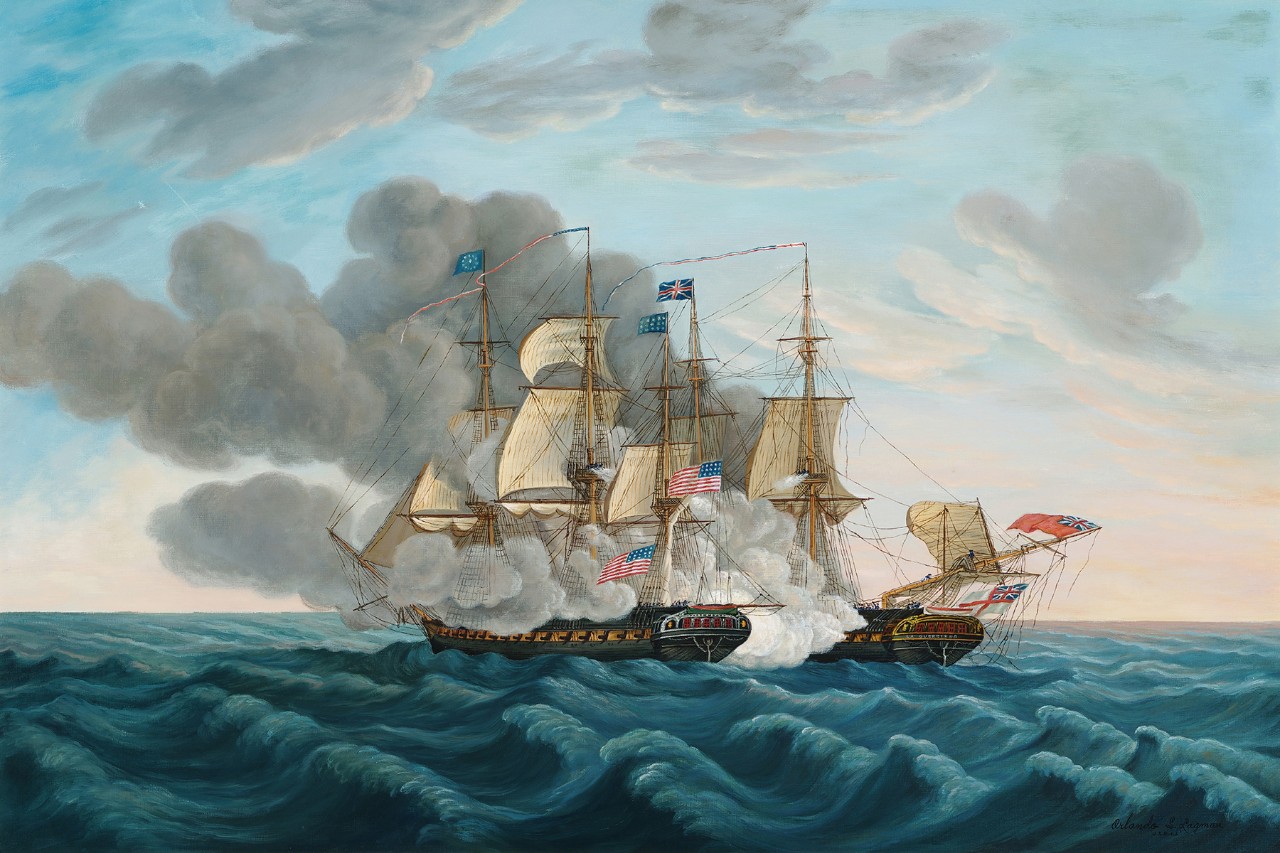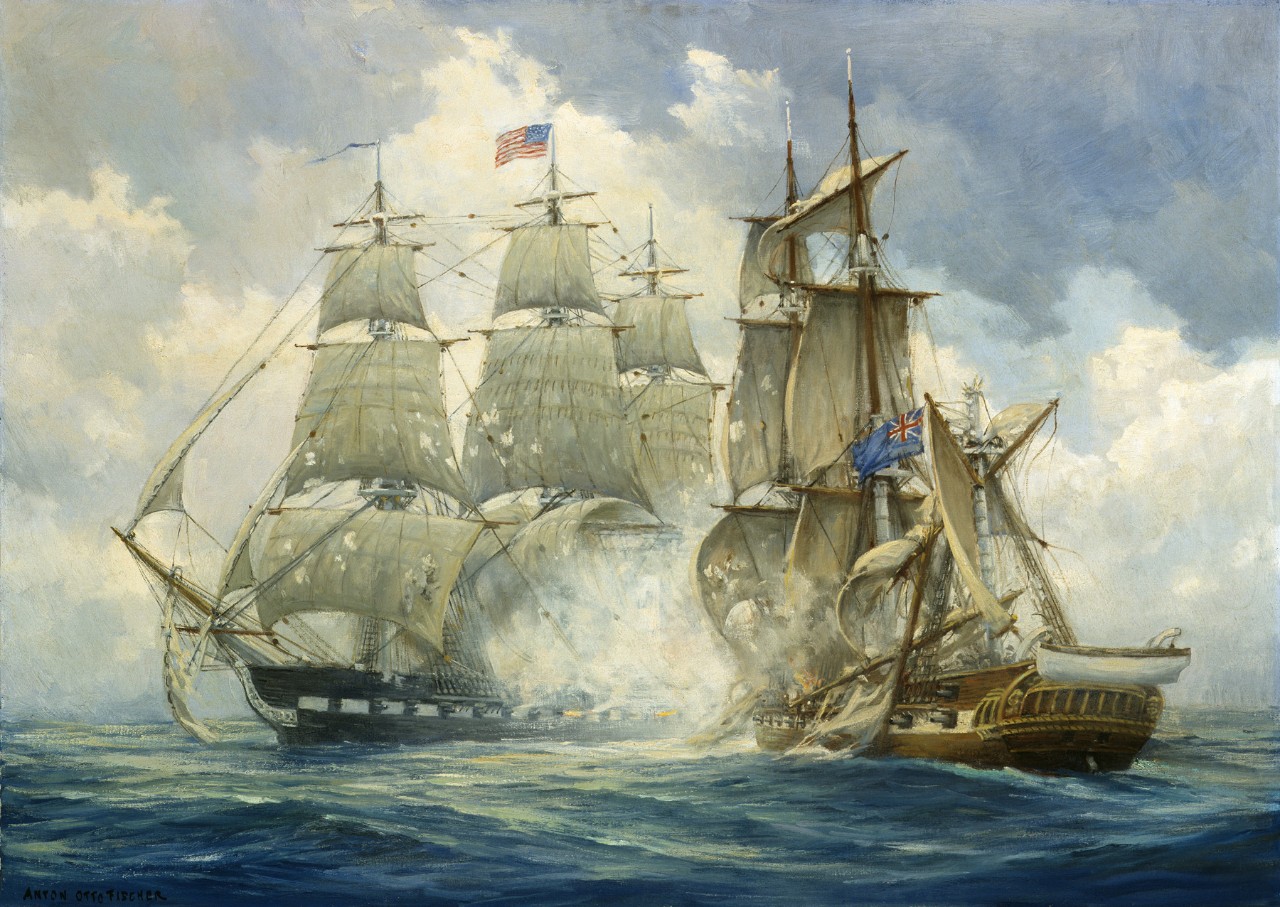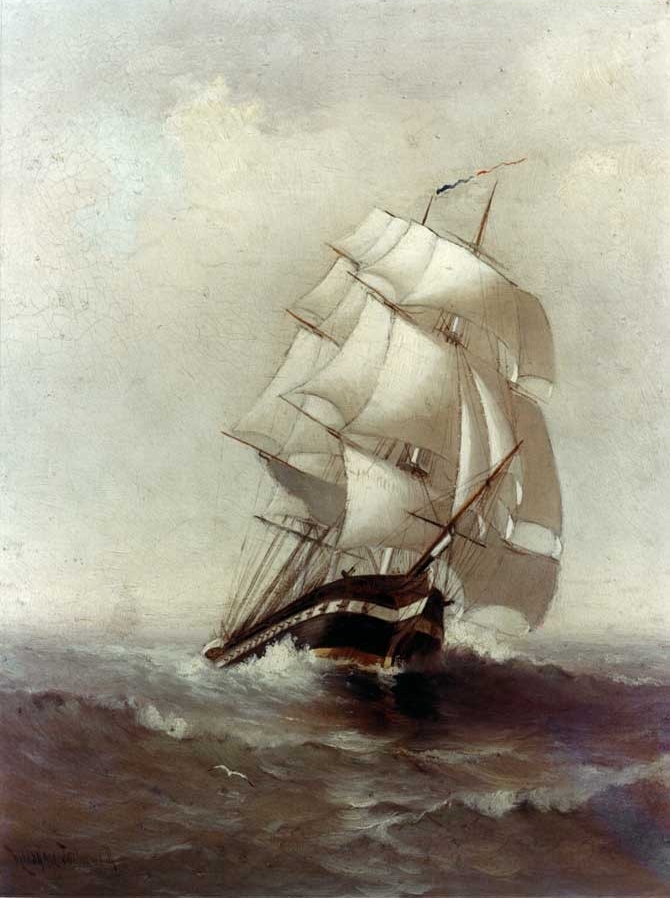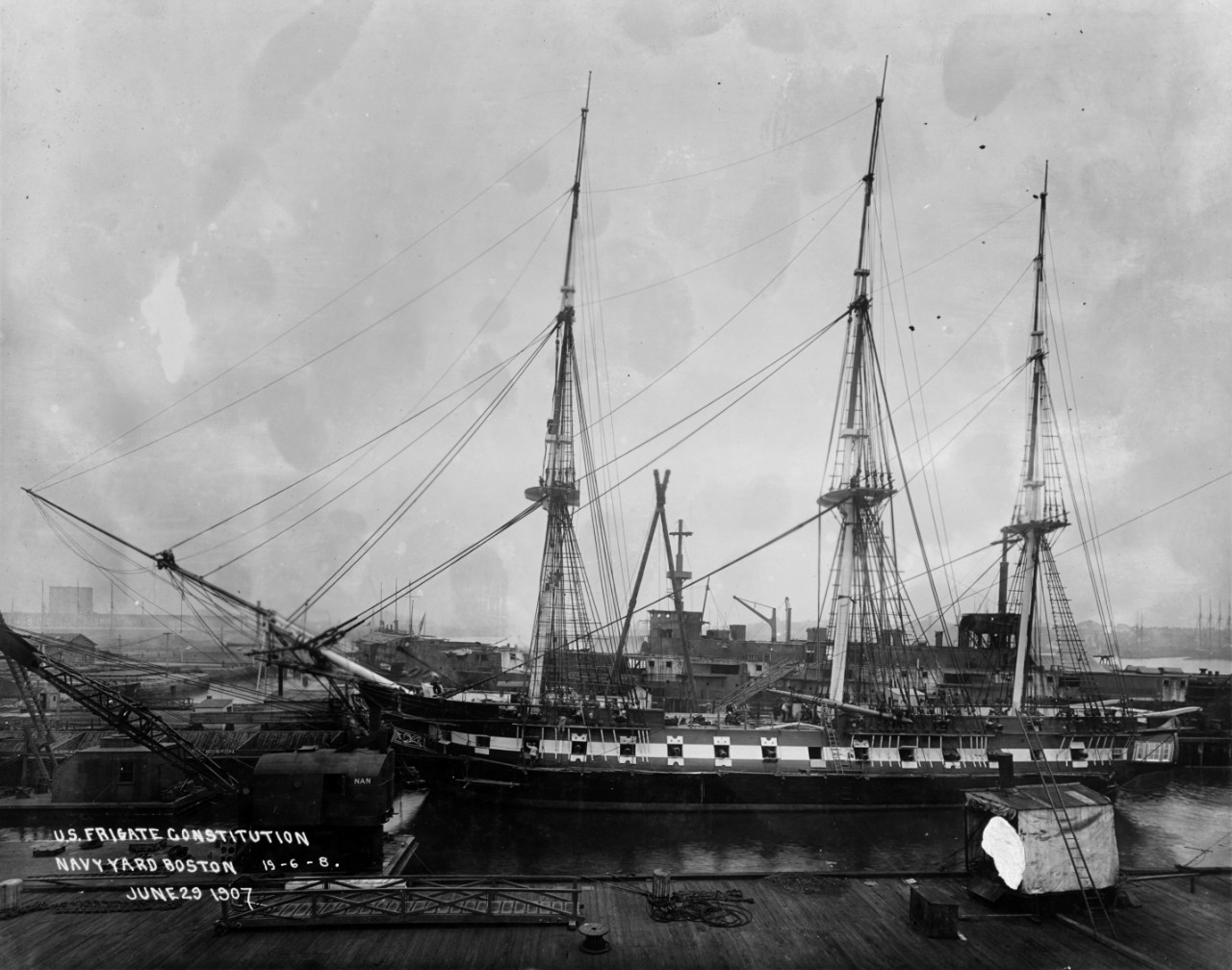Constitution
(Fr: dp. 2,200; lbp. 175'; b. 43'6"; dph. 14'3"; s. 13 k.; cpl. 450; a. 30 24-pdr., 16 18 pd.car., 10 12-pdr.)
The written instrument embodying the fundamental organic law and principles of government of the United States of America.
Constitution, one of six frigates authorized by act of Congress, approved 27 March 1794, was designed by Joshua Humphreys, and built at Hartt's Shipyard, Boston, Mass., under the supervision of George Claghorn with Captain Samuel Nicholson as inspector. She was launched on 21 October 1797 and christened by Captain James Sever.
Into the trim frigate's construction went timbers from States ranging from Maine to Georgia, as well as copper bolts and spikes supplied by Paul Revere. A ship of beauty, power, and speed thus was fashioned as a national expression of growing naval interest, and a symbol auguring the dedication, courage, and achievement of American fighting men and ships.
Constitution put to sea on 23 July 1798, commanded by Captain Samuel Nicholson, the first of many illustrious commanding officers. Following patrols along the Eastern Seaboard she became flagship on the Santo Domingo station, making several captures including the 24-gun Niger, the Spencer, and the letter-of-marque Sandwich. At war's end, Constitution returned to the Charleston Navy Yard where she was placed in ordinary.
In 1803 amid growing demand for tribute and increasing seizures by the Barbary pirates, Constitution was recommissioned under Captain Edward Preble and sailed as flagship of the Mediterranean Squadron on 14 August. Preble took command of the squadron and vigorously brought the war to Tripoli, executing well-laid plans with brilliant success. On Constitution's decks tactics for destroying the captured frigate, Philadelphia, were laid as well as those for blockading and assaulting the fortifications of Tripoli. The small United States fleet on 3 and 7 August 1804 bombarded the enemy's ships and shore batteries with telling results.
Commodore Samuel Barron and later Captain John Rodgers were next to command the squadron and Constitution, continuing to blockade and take prizes. Naval action thus generated a favorable climate for the negotiation of peace terms with Algiers, ending for a time our tribute payments. After the Tunisians agreed to similar terms in August, Constitution spent 2 years patrolling in maintenance of the peace. She sailed for home under Captain Hugh Campbell and arrived Boston in November 1807. Placed out of commission, the frigate was repaired in the succeeding 2 years.
In August 1809 she was recommissioned and became flagship of the North Atlantic Squadron, Commodore J. Rodgers, and in 1810 Isaac Hull was appointed her captain. The following year she carried U.S. Minister, Joel Barlow, to France and returned to Washington in March 1812 for overhaul. War with Britain impended and Constitution was readied for action. On 20 June 1812 the declaration of war was read to her assembled crew and on 12 July she took the sea under Captain Hull to rejoin the squadron of Commodore J. Rodgers.
On 17 July Constitution sighted five ships in company; supposing them to be Rodger's squadron, Hull attempted to join up. By the following morning, however, the group was identified as a powerful British squadron which included the frigates Guerriere and Shannon. The wind failed, becalming within range of the enemy who opened fire. Disaster threatened until Captain Hull astutely towed, wetted sails, and kedged to draw the ship slowly ahead of her pursuers. For 2 days all hands were on deck in this desperate and successful attempt at escape, a splendid example of resolute command, superior seamanship, and indefatigable effort.
During the war, Constitution ran the blockade at Boston on seven occasions and made five cruises ranging from Halifax, Nova Scotia, south to Guiana and east to Portugal. She captured, burned, or sent in as prizes nine merchantmen and five ships of war. Departing Boston on 2 August she sailed to the coast of Nova Scotia, where she captured and destroyed two British trading ships. Cruising off the Gulf of St. Lawrence on 19 August, she caught sight of Guerriere, a fast British frigate mounting 49 guns. Guerriere opened the action, pouring out shot which fell harmlessly into the sea or glanced ineffectively from the hull of Constitution whose cheering crew bestowed on her the famous nickname "Old Ironsides," which has stirred generations of Americans. As the ships drew abreast, Hull gave the command to fire and successive broadsides razed Guerriere's mizzen mast, damaging her foremast, and cut away most of her rigging. Guerriere's bowsprit fouled the lee rigging of Constitution, and both sides attempted to board, but the heavy seas prevented it. As the ships separated Guerriere fired point blank into the cabin of Constitution and set it on fire, but the flames were quickly extinguished. Guerriere's foremast and mainmast went by the board and she was left a helpless hulk.
The flag of Guerriere was struck in surrender and when the Americans boarded her they found her in such a crippled condition that they had to transfer the prisoners and burn her. It was a dramatic victory for America and for Constitution. In this battle of only half an hour the United States "rose to the rank of a first-class power"; the country was fired with fresh confidence and courage; and union among the States was greatly strengthened.
Constitution, Commodore William Bainbridge, stood out from Boston on 26 October. On 29 December 1812 she added to her conquest the British 38-gun frigate, Java, whom she engaged off the coast of Brazil. Despite loss of her wheel early in the fighting, Constitution fought well. Her superior gunnery shattered the enemy's rigging, eventually dismasting Java, and mortally wounding her captain. Java was so badly damaged that she, too, had to be burned. The seemingly invincible "Old Ironsides" returned to Boston late in February for refitting and her wounded commander was relieved by Captain Charles Stewart.
Constitution departed on 31 December for a cruise in the Windward Islands. On 15 February she seized and destroyed the schooner, Pictou, and 9 days later chased the schooner, Pique, who escaped. She also captured three small merchantmen on this cruise, characteristically successful despite a close pursuit by two British frigates along the coast of Massachusetts. Constitution moored safely at Boston only to be bottled up for nearly 9 months by the vigorous British blockade.
In December 1814 Constitution braved the forces of the enemy, and headed southeast. She seized the merchant brig Lord Nelson and later captured Susannah with a rich cargo on 16 February 1815. Four days later she gave close chase to the frigate Cyane and the sloop Levant bound for the West Indies. Constitution opened the action firing broadsides; as the contestants drew apart she maneuvered adroitly between the two, fighting each separately and avoiding raking by either. In less than an hour Cyane struck her colors and soon thereafter Levant surrendered. Sailing in company with her prizes, Constitution encountered a British squadron which gave chase but was able to retake only Levant. En route to New York, she received confirmation of the ratification of peace terms and on 15 May arrived, confident in her success as protector of freedom of the seas.
Ordered to Boston, she was placed in ordinary for 6 years, undergoing extensive repair. In May 1821 she returned to commission, serving as flagship of the Mediterranean Squadron, under Commodore Jacob Jones, and guarding United States shipping until 1823. A second cruise on that station lasted from 1823 through July 1828, with a succession of commanding officers including Captain Thomas Macdonough and Daniel Patterson.
A survey in 1830 disclosed Constitution to be unseaworthy. Congress, considering the projected cost of repairs, relegated her for sale or scrapping. Public sentiment, engendered partly by the dramatization of her history in Oliver Wendell Holmes' memorable poem, elicited instead an appropriation of money for reconstruction which was begun in 1833 at Boston, where once again she was captained by the redoubtable Isaac Hull.
Constitution (1797-) oil on canvas, 18 x 14, by Marshall Johnson, Jr., circa 1896. It depicts the ship under sail during her eastbound voyage around the World, 30 May 1844-27 September 1846, while under the command of Captain John Percival. The original painting is in the U.S. Naval Academy Museum, Annapolis, Maryland. It was donated by Nelson B. Gaskill in 1960. Official U.S. Navy photograph now in the collections of the National Archives, KN-10966.
Returned to commissioned status in 1835, she served well in the ensuing 20 years in a variety of missions. In March 1835 she sailed to France where she embarked the U.S. Minister to France, Edward Livingston, for return to the States. In August she entered upon a 3-year tour as flagship of Commodore Jesse Elliott in the Mediterranean protecting trade and maintaining good relations. She served as flagship for the South Pacific Squadron from 1839 to 1841; and for the home station from November 1842 to February 1843. In March 1844 she began a memorable 30-month circumnavigation of the globe while under the command of Captain John Percival.
The Fall of 1848 brought a resumption of duty as flagship of the Mediterranean Squadron, Commodore W. C. Bolton. Decommissioned briefly in 1851 she sailed under Captain John Rudd in 1852 to patrol the west coast of Africa in quest of slavers until June 1855.
Five years of decommissioned status followed. In August 1860 she was assigned to train midshipmen at Annapolis, and during Civil War at Newport, R.I. Among her commanding officers in this period are listed Lieutenant Commanders David D. Porter, and George Dewey.
In 1871 Constitution underwent rebuilding at Philadelphia; she was commissioned again in July 1877 to transport goods to the Paris Exposition.
Once more she returned to duty as a training ship, cruising from the West Indies to Nova Scotia with her youthful crews. In January 1882 she was placed out of commission and in 1884 was towed to Portsmouth, N.H., to become a receiving ship. Celebration of her centennial year brought her to Boston in 1897 where she was retained in decommissioned status.
A public grateful for her protective services once again rescued her from imminent destruction in 1905 and she was thereafter partially restored for use as a national museum. Twenty years later, complete renovation was initiated with the financial support of numerous patriotic organizations and school children.
On 1 December 1917, Constitution was renamed Old Constitution to permit her original name to be assigned to a projected battle cruiser. Given first to CC-1 (renamed Lexington (q.v.)) then to CC-5 (originally named Ranger (q.v.)), the name Constitution was restored to "Old Ironsides" on 24 July 1925, after the battle cruiser program had been canceled under the Washington naval treaty. Constitution (CC-5) was some 13.4 percent complete at the time of her cancellation. (For design characteristics, see Vol. I, pp. 210 and 211).
On 1 July 1931, amid a 21-gun salute, Constitution was recommissioned. The following day she sailed on a triumphant tour of 90 United States' ports along the Atlantic, Pacific, and Gulf coasts, where thousands of Americans saw at first hand one of history's greatest fighting ships. On 7 May 1934 she returned to Boston Harbor, the site of her building. Classified IX-21 on 8 January 1941, Constitution remains in commission today, the oldest ship on the Navy List, proud and worthy representative of the Navy's great days of fighting sail, and symbol of the courage and patriotic service of generations of Americans at sea where much of the Nation's destiny will always lie.






